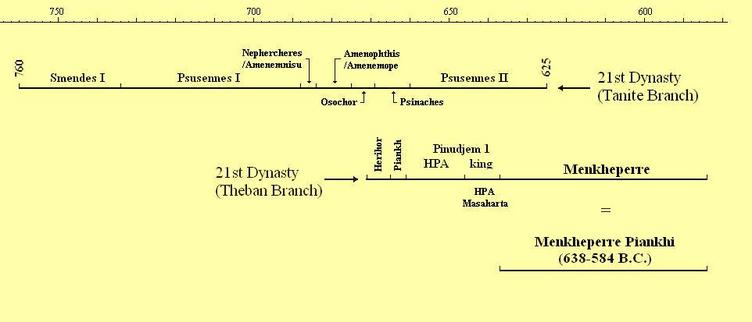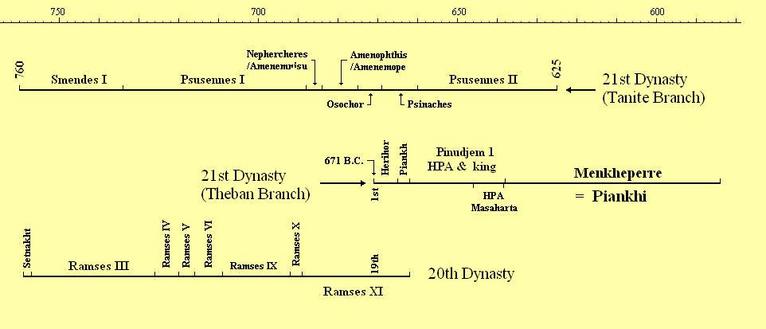Volume 2 - Piankhi the Chameleon
The emphasis in volume 1 of our Displaced Dynasties series was on the 26th dynasty. It dealt summarily with the history of the 7th century B.C., arguing only that throughout the one hundred year interval between the Assyrian occupation of Egypt (671-664 B.C. in the traditional history) and the invasion of Egypt by Nebuchadrezzar (564 B.C.), Egypt was parceled out among the last pharaohs of the 22nd and 23rd dynasties, the enigmatic Bocchoris of the 24th dynasty, and most importantly, the 25th dynasty ancestors of Taharka, including Piankhi, Shabaka and Shabataka. It is these kings of the Ethiopian 25th dynasty that occupy our attention in the second book of our series. In particular it is Piankhi that arrests our attention.
Piankhi the Chameleon sets out to prove the proposition, stated briefly in Nebuchadnezzar, that the pharaoh named Neco in the Hebrew Bible was Piankhi, the founder of the 25th dynasty, whose Horus name Nakht Ka (strong bull) was the likely source of the nickname parodied by the Jewish authors. The argument is proposed, and defended in the first five chapters of the book, that Piankhi adopted as his own the throne names of the famed warrior king Menkheperre Thutmose III of the 18th dynasty, and that in this name he recorded his battles for supremacy over Syria in the late 7th century B.C. A month by month comparison between Piankhi's Annals, inscribed on the walls of the Karnak temple, and the Babylonian Chronicles of Nabopolassar and Nebuchadrezzar for the identical 15 years period, establishes the proposed identity beyond reasonable doubt.
This identification of Piankhi with pharaoh Neco of the Hebrew Bible, and with Menkheperre Thutmose of the Amun temple Annals, leaves unchanged the relative chronology of the revised history proposed in Nebuchadnezzar. But that history is itself radically altered by the acquisition of yet a third identity by the chameleon-like Piankhi. The similarity in name, the length of term in office, and assorted other parallels between the ultra religious 25th dynasty Menkheperre Piankhi and a 21st dynasty priest/king named Menkheperre, led to the conclusion that the two individuals were one and the same person. This caused us to move the entire 21st Theban dynasty of priest/kings to which Piankhi belonged, hundreds of years forward into the 7th century, and to identify them as the extended family of Piankhi. How surprising to discover that Piankhi's ancestors where not unknown, as the traditional history had long led us to suspect, but that his father and grandfather, Pinudjem I and Piankh, and his son and grandson, Pinudjem II and Psusennes III, were well known historical figures, unfortunately divorced from their near relative by the errant chronology we are attempting to set right.
Piankhi the Chameleon sets out to prove the proposition, stated briefly in Nebuchadnezzar, that the pharaoh named Neco in the Hebrew Bible was Piankhi, the founder of the 25th dynasty, whose Horus name Nakht Ka (strong bull) was the likely source of the nickname parodied by the Jewish authors. The argument is proposed, and defended in the first five chapters of the book, that Piankhi adopted as his own the throne names of the famed warrior king Menkheperre Thutmose III of the 18th dynasty, and that in this name he recorded his battles for supremacy over Syria in the late 7th century B.C. A month by month comparison between Piankhi's Annals, inscribed on the walls of the Karnak temple, and the Babylonian Chronicles of Nabopolassar and Nebuchadrezzar for the identical 15 years period, establishes the proposed identity beyond reasonable doubt.
This identification of Piankhi with pharaoh Neco of the Hebrew Bible, and with Menkheperre Thutmose of the Amun temple Annals, leaves unchanged the relative chronology of the revised history proposed in Nebuchadnezzar. But that history is itself radically altered by the acquisition of yet a third identity by the chameleon-like Piankhi. The similarity in name, the length of term in office, and assorted other parallels between the ultra religious 25th dynasty Menkheperre Piankhi and a 21st dynasty priest/king named Menkheperre, led to the conclusion that the two individuals were one and the same person. This caused us to move the entire 21st Theban dynasty of priest/kings to which Piankhi belonged, hundreds of years forward into the 7th century, and to identify them as the extended family of Piankhi. How surprising to discover that Piankhi's ancestors where not unknown, as the traditional history had long led us to suspect, but that his father and grandfather, Pinudjem I and Piankh, and his son and grandson, Pinudjem II and Psusennes III, were well known historical figures, unfortunately divorced from their near relative by the errant chronology we are attempting to set right.
Even at this point we were not finished. Since we had moved the Theban 21st dynasty from the 11th century into the 7th, we were compelled to move along with it the Tanite branch of that same dynasty. Investigation had shown that the last Tanite king Psusennes II was a contemporary of Piankhi's father Pinudjem I. Thus the Tanite priest/kings were moved forward into the 8th and early 7th centuries.
Finally, since Piankhi's grandfather Piankh lived near the end of the whm mswt, that mysterious period of civil unrest which began in the 17th year of Ramses XI of the 20th dynasty, we had inadvertently discovered the true time frame for the conclusion of the 20th dynasty. Thus by the end of our second book we had fixed in place both the 20th and the 21st (Tanite & Theban) dynasties. At this point our 3rd book, The Genealogy of Ashakhet takes up the cause.
|
Table of Contents & Preface Chapter 1: Piankhi - 618 B.C. The Tefnakht Rebellion Piankhi: The Traditional View Piankhi: Alternative Dating Chapter 2: The Piankhi Inscriptions: 616-610 B.C. The Babylonian Chronicle Menkheperre Thutmose The Annals of Menkheperre Chapter 3: The Last Days of the Assyrian Empire 610-609 B.C. (According to the Chronicle & the Hebrew Bible) Identity of the Egyptian Pharaoh Necho Menkheperre's 5th & 6th Campaigns The Memoirs of Amenemheb Mariannu & the Josiah Succession Chapter 4: Battles in Naharin Wiseman's Overview The Siege of Kimuhu, Sept.-Nov. 607 B.C. March/April 606 - March/April 605 B.C. March/April 605 - March/April 604 B.C. March/April 604 - March/April 603 B.C. Chapter 5: Piankhi's Phoenician Empire December 604 - December 601 B.C. March/April 600 - March/April 596 B.C. The Phoenician Empire of Menkheperre Chapter 6: Aakheperure & Menkheperure Duplicate Dynasties: the 18th & 25th Aakheperure Amenhotep Menkheperure Thutmose |
Chapter 7: 20th & 21st Dynasties Relocated The Priest King Menkheperre 21st Dynasty Chronology (Traditional History) A Modified Chronology (Revised History) Final Transposition of the 21st Dynasty "Theban Branch" 20th Dynasty (Revised History) Chapter 8: Herihor, Piankh & Pinudjem I Herihor, Ramses XI & the Whm Mswt Wenamun & Nesubanebdjed Herihor-Piankh Succession Pinudjem I & Psusennes II Chapter 9: Descendants of Pinudjem I Pinudjem I (continued) The Inscriptions of Pinudjem I Masaharta & the Tomb of Merytamun Menkheperre & the Liberation of Egypt The Sons & Grandson of Piankhi Appendices A-D A: The Pasenhor Genealogy B: Hedjkheperre Sheshonk - A re-evaluation C: The Descendants of Menkheperre D: God's Wives of Amun Index |
Copyright © 2000 Displaced Dynasties. All Rights Reserved.



